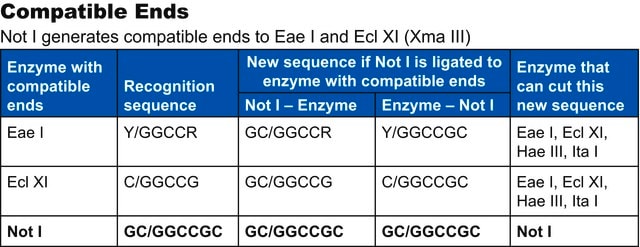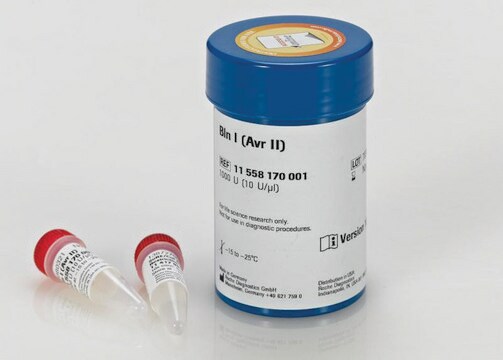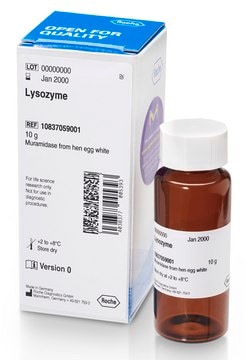SPEI-RO
Roche
Spe I
from Sphaerotilus species
Synonym(s):
Spe I, SPE I
About This Item
Recommended Products
biological source
bacterial (Sphaerotilus spp.)
Quality Level
form
solution
specific activity
10000 U/mL
packaging
pkg of 1,000 U (11008951001 [10 U/μl])
pkg of 1,000 U (11207644001 [40 U/μl])
pkg of 200 U (11008943001 [10 U/μl])
manufacturer/tradename
Roche
parameter
37 °C optimum reaction temp.
color
colorless
pH
8.0 (39 °F)
solubility
water: miscible
suitability
suitable for molecular biology
application(s)
life science and biopharma
sample preparation
foreign activity
Endonucleases 10 units, none detected
shipped in
dry ice
storage temp.
−20°C
Related Categories
General description
Specificity
*A*CTAGT
Restriction site: *A↓*CTAGT
*A↓*CTAGT
Heat inactivation: Spe I can be heat inactivated by incubation at 65 °C for 15 minutes (up to 100 U/μg DNA).
Quality
1μg Ad2 DNA is incubated for 16 hours in 50μl SuRE/Cut Buffer H with an excess of Spe I. The number of enzyme units which do not change the enzyme-specific pattern is stated in the certificate of analysis.
Absence of exonuclease activity
Approximately 5μg [3H] labeled calf thymus DNA are incubated with 3μl Spe I for 4 hours at +37°C in a total volume of 100μl 50mM Tris-HCl, 10mM MgCl2, 1mM Dithioerythritol, pH approximately 7.5. Under these conditions, no release of radioactivity is detectable, as stated in the certificate of analysis.
DNA Profile
- λ: 0
- φX174: 0
- Ad2: 3
- M13mp7: 0
- pBR322: 0
- pBR328: 0
- pUC18: 0
- SV40: 0
Unit Definition
Storage and Stability
Analysis Note
Spe I ends are compatible with ends generated by Bln I, Nhe I, and Xba I.
Isoschizomers
The enzyme is an isoschizomer of Bcu I and Ahl I.
Methylation sensitivity
As indicated by (*) on the recognition sequence above, Spe I is inhibited by the presence of N6-methyladenine and 5′-methylcytosine ( mA↓m CTAGT).
Incubation temperature
+37°C
PFGE tested
Spe I has been tested in Pulsed-Field Gel Electrophoresis (on bacterial chromosomes). For cleavage of genomic DNA (E. coli C 600) embedded in agarose for PFGE analysis, we recommend using 10U of enzyme/μg DNA and 4 hour incubation time.
Ligation and recutting assay
Spe I fragments obtained by complete digestion of 1μg Ad2 DNA are ligated with 1U T4 DNA Ligase in a volume of 10μl by incubation for 16 hours at +4°C in 66mM Tris-HCl, 5mM MgCl2, 5mM Dithiothreitol, 1mM ATP, pH 7.5 (at +20°C), resulting in >90% recovery of Ad2 DNA.
Subsequent re-cutting with Spe I yields >95% of the typical pattern of Ad2 × Spe I fragments.
The buffer in bold is recommended for optimal activity
- A: 75-100%
- B: 75-100%
- H: 100%
- L: 75-100%
- M: 100%
Other Notes
Kit Components Only
- Enzyme Solution
- SuRE/Cut Buffer H 10x concentrated
Storage Class Code
12 - Non Combustible Liquids
WGK
WGK 1
Flash Point(F)
does not flash
Flash Point(C)
does not flash
Certificates of Analysis (COA)
Search for Certificates of Analysis (COA) by entering the products Lot/Batch Number. Lot and Batch Numbers can be found on a product’s label following the words ‘Lot’ or ‘Batch’.
Already Own This Product?
Find documentation for the products that you have recently purchased in the Document Library.
Articles
The term “Restriction enzyme” originated from the studies of Enterobacteria phage λ (lambda phage) in the laboratories of Werner Arber and Matthew Meselson.
Related Content
Restriction endonucleases popularly referred to as restriction enzymes, are ubiquitously present in prokaryotes. The function of restriction endonucleases is mainly protection against foreign genetic material especially against bacteriophage DNA.
Our team of scientists has experience in all areas of research including Life Science, Material Science, Chemical Synthesis, Chromatography, Analytical and many others.
Contact Technical Service





